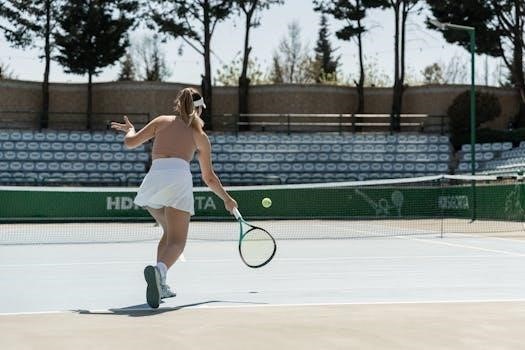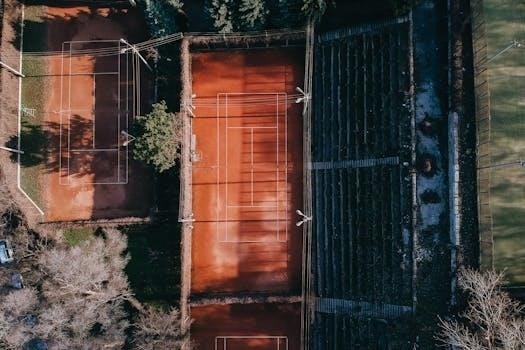Tennis Court Dimensions⁚ A Comprehensive Guide
Welcome to a detailed exploration of tennis court dimensions! This guide provides essential information for players, coaches, and enthusiasts. Understand the specifics, from overall size to key measurements. Learn about historical context and modern standards, ensuring fair play and consistent court design.
Understanding tennis court dimensions is fundamental for anyone involved in the sport, from casual players to professional athletes and facility managers. The International Tennis Federation (ITF) sets the standard, ensuring consistency and fairness across all levels of play. These dimensions dictate the playing area for both singles and doubles matches, influencing strategy and gameplay.
This comprehensive guide will explore the specifics of tennis court measurements, including overall length and width, service lines, and net height. We will also delve into variations in court size, such as those used for junior players and tournament settings. Whether you’re constructing a new court or simply seeking to deepen your understanding of the game, this information will prove invaluable. Knowing the precise dimensions contributes significantly to appreciating the sport’s integrity and maintaining consistent playing conditions.

Standard Tennis Court Dimensions
This section details the official measurements for standard tennis courts. We’ll cover overall dimensions for both singles and doubles play. These measurements are crucial for ensuring fair and consistent gameplay according to ITF standards.
Overall Dimensions⁚ Length and Width
The overall dimensions of a standard tennis court are crucial for both singles and doubles play. The total length of the court, from baseline to baseline, measures 78 feet (23.77 meters). This length remains consistent regardless of whether the court is used for singles or doubles matches.
However, the width of the court varies depending on the game being played. For doubles matches, the width extends to 36 feet (10.97 meters). When playing singles, the width is narrower, measuring 27 feet (8.23 meters). These dimensions are defined by the International Tennis Federation (ITF) to ensure standardized play.
Understanding these basic measurements is the first step in comprehending the layout and regulations of a tennis court. Accurately marked lines defining these dimensions are essential for fair competition.
Singles Court Dimensions
The singles court utilizes a narrower width compared to the doubles court, maintaining the same length of 78 feet (23.77 meters). The width of the singles court measures 27 feet (8.23 meters), defined by the inner sidelines. These sidelines run parallel to each other, creating the boundaries for singles play.
It’s important to note that the outer sidelines, used for doubles, are not considered in play during a singles match. The service lines, baselines, and net remain consistent for both singles and doubles. Understanding these specific dimensions is crucial for players to accurately judge shot placement and court coverage during a singles game.
The precise markings ensure fair play and adherence to the rules established by the International Tennis Federation (ITF). Players must be aware of these boundaries to effectively compete in singles matches.
Doubles Court Dimensions
The doubles court expands the width of the playing area compared to the singles court, while maintaining the same length of 78 feet (23.77 meters). The width of the doubles court measures 36 feet (10.97 meters), utilizing the outer sidelines. These sidelines run parallel to each other, creating the boundaries for doubles play.
This wider court provides additional space for players to cover, accommodating the presence of two players on each side. The service lines, baselines, and net height remain consistent for both singles and doubles, ensuring uniformity in gameplay elements. The additional width significantly impacts strategy and court positioning.
Understanding these specific dimensions is crucial for players to effectively utilize the court space and coordinate with their partners during a doubles match. The precise markings guarantee adherence to the rules established by the International Tennis Federation (ITF).

Key Areas and Measurements
Delve into the crucial measurements that define a tennis court. Discover baseline and sideline distances, service line placement, and net height. Understanding these elements ensures fair play and accurate court construction, according to ITF guidelines.
Baseline and Sideline Distances
The baseline, located at the far ends of the court, is a critical boundary. The distance from the baseline to the net is 39 feet (11.89 meters). Sidelines define the width of the court, differing for singles and doubles play. For singles, the sideline-to-sideline distance is 27 feet (8.23 meters). Doubles play utilizes a wider court, measuring 36 feet (10.97 meters) between the sidelines.
These distances are fundamental for defining the playing area. Players must understand these boundaries to ensure their shots land within legal limits. Proper marking of these lines is essential during court construction.
Precise measurements ensure consistent gameplay. Referees rely on these dimensions to make accurate calls; Understanding baseline and sideline distances improves players’ strategic positioning and shot placement during matches, enhancing their overall performance.
Service Line Distance from the Net
The service line is a crucial marking on a tennis court. It runs parallel to the net, defining the area into which a serve must land to be considered valid. This line is positioned 21 feet (6.40 meters) away from the net. The service line extends only to the singles sideline, marking the boundary for serves in both singles and doubles play.
Understanding this distance is vital for serving accurately. Players must aim to land their serves within the service box, bounded by the service line, the singles sideline, and the net. A serve landing outside this area results in a fault.
The service line distance ensures fair play and challenges players to develop precision in their serves, encouraging strategic gameplay within defined parameters. Accurate measurement of this distance is important.
Net Height
The net is a central component of a tennis court, dividing it into two equal halves. Its height is precisely regulated to ensure fair play. According to the International Tennis Federation (ITF) rules, the net’s height at the center should be 3 feet (0.914 meters). At the net posts, the height is slightly greater, measuring 3 feet 6 inches (1.07 meters).
This difference in height creates a gentle slope from the posts to the center, impacting gameplay and strategy. The lower center net height encourages net play, requiring players to hit shots that clear the net while remaining within the court’s boundaries.
Maintaining the correct net height is crucial for consistent and fair competition. Regular checks are important to address sagging or stretching that may occur over time, ensuring adherence to ITF standards.
Variations in Court Size
While standard tennis court dimensions are well-defined, variations exist. These cater to different levels and purposes, such as junior courts and tournament venues. Understanding these variations ensures appropriate playing conditions for all participants and events.
Tournament and Stadium Courts
Tournament and stadium courts often exceed standard tennis court dimensions to accommodate additional space. This extra area provides ample room for judges, linespersons, and player overrun during intense matches. An additional 10 feet on both length and width is often suggested, enhancing safety and functionality.
These expanded dimensions are crucial for professional play, allowing for better movement and reaction time. The increased space also allows for the placement of essential equipment and personnel without interfering with gameplay. Ensuring these dimensions contributes to the overall viewing experience for spectators.
For example, an overall court length of 130 feet is not uncommon. This consideration guarantees that high-level competition can occur without constraints, adhering to the highest standards. The specific dimensions may vary depending on the venue and tournament regulations.
Junior Courts (Red Courts)
Red courts are specifically designed for young children under 8 years old, providing a scaled-down environment suitable for their developing skills. These courts feature significantly smaller dimensions compared to standard tennis courts, ensuring a more manageable and enjoyable playing experience for beginners.
Typically, a red court measures 11 meters (36 feet) in length and 5.5 meters (18 feet) in width. The net height is consistently set at 0.8 meters in the center, promoting proper technique and encouraging successful rallies. These reduced dimensions help children develop fundamental tennis skills more effectively.
The smaller court size allows young players to cover the court more easily, improving their ability to reach the ball and maintain rallies. This setup fosters confidence and encourages continued participation in tennis. Red courts provide an ideal introduction to the sport for aspiring young athletes.

Tennis Court Surfaces and Their Impact
The surface of a tennis court significantly influences the game’s dynamics, affecting ball speed, bounce height, and player movement. Different materials offer unique playing characteristics, catering to various styles and preferences. Understanding these surface variations is crucial for both players and court builders.
Common tennis court surfaces include grass, clay, hard courts (such as acrylic or asphalt), and synthetic materials. Grass courts, known for their fast pace and low bounce, favor serve-and-volley players. Clay courts, conversely, produce a slower pace and higher bounce, benefiting players with strong baseline games.
Hard courts offer a medium-fast pace and consistent bounce, making them a versatile choice for all-around players. Synthetic surfaces can mimic the properties of other surfaces while providing enhanced durability and lower maintenance. The choice of surface impacts strategy, technique, and overall playing experience.

Construction Guidelines and Considerations
Constructing a tennis court requires careful planning and adherence to specific guidelines to ensure optimal playability, longevity, and safety. Proper site preparation is essential, including leveling the ground and ensuring adequate drainage to prevent water damage and maintain surface integrity. Dimensions must comply with ITF standards.
Choosing the right materials for the base, surface, and fencing is crucial. Factors to consider include climate, budget, and desired playing characteristics. Proper installation of the net, lines, and lighting is also vital for a functional and enjoyable tennis court.
Additionally, consider accessibility requirements and safety features, such as appropriate fencing height and padding for posts. Regular maintenance is necessary to prolong the life of the court and maintain its playing quality. Consulting with experienced court builders is highly recommended for a successful construction project.
